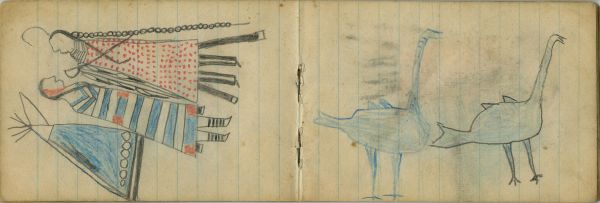BIRDS: Two Blue Turkeys
Ethnographic Notes
Horizontal BIRDS: Two Blue Turkeys The two large birds have very long necks with distinctive rings. Their claws are three-toed. Wings show, as well as tailfeathers. The bird on the right is outlined in lead pencil and filled with blue (crayon). The bird on the left is outlined, detailed, and filled with blue. The tailfeathers are blunt with a Vee shape. Turkeys were a common game bird on the southern plains. Richard Irving Dodge describes a hunt of twenty days in October of 1872, and his party killed 154 turkeys �in the country south-east of Fort Dodge, on the small tributaries of the Cimarron River� (1876, rpt. 1959: 118). Arrow�s Elk Society Ledger depicts three turkey hunts (Plates 92, 118, 120, Cowdrey, 1999). Cowdrey writes: �The Cheyenne word for �turkey� is maxen (Moore, 1986: Fig. 5) They were so plentiful on the Southern Plains that Solomon river, a branch of the Republican, was named for them: Maxeneo Ohe �River of Turkeys� (Grinnell, 1906: 17-18; Grinnell�s spelling is Mahkine ohe)� (1999: 157). Cowdrey further explains that turkey tail feathers had desirable �iridescent copper highlights� (157). George Bird Grinnell notes �Turkey feathers or buzzard feathers were the best for [making] arrows, because blood does not affect them� (1923, I: 181). Turkeys appear in this ledger in Plates 33, 35, and 72.

